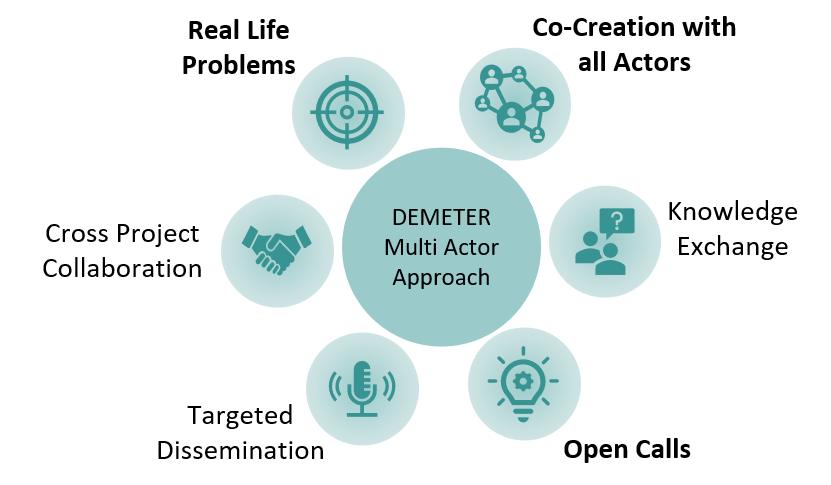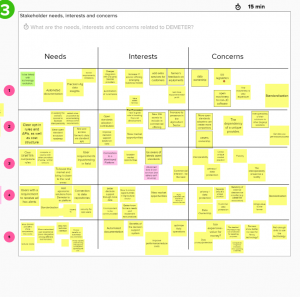
Anja Linnemann, Fraunhofer and Dave Hearne, TSSG
What is the MAA?
The multi-actor approach (MAA) ensures that projects, like DEMETER, focus on real needs and problems that an end-user (farmer, advisor, IT provider etc.) is facing. As we are building innovative solutions that address specific needs or problems, while involving the end-user in the process, the resulting product is highly adopted.
MAA also encourages stakeholder engagement from the beginning and throughout each project which means that there is collaboration from multiple partners, end-users, and other stakeholders. All of these differing views and opinions from multiple actors allows us to create a solution that is more readily applied and adopted once completed. All actors have a sense of ownership as they are involved throughout the process.
All MAA activities within DEMETER are managed by Work Package 7 (Multi-Actor Ecosystem Development).
Why is the MAA important?
The multi-actor approach is used to ensure that newly developed technical solutions meet real life needs. Only a clear understanding of the problem and the expectations of all relevant stakeholders leads to a solution that addresses the real need, i.e., is really useful. In order to ensure the acceptance of the technical solution and thus its long-term use, usability is also crucial.
Furthermore, the MAA supports communication and the exchange of knowledge across existing borders (such as local, national or cultural borders), so that on the one hand our acquired knowledge is made available, but also so that DEMETER benefits from other projects and experiences.
How is the MAA being used within DEMETER?
The multi-actor approach in DEMETER is primarily built on our 20 pilots which are active in several European countries and in different agro-domains. The pilots represent our key users and also bring their domain knowledge and experience to the iterative development, thus being an active part of the co-creation of the technical solution.
With the support of our pilots, DEMETER relevant stakeholders are regularly analysed with their needs, interests and goals requested through interviews, workshops and surveys. This input is incorporated into the technical development, which is also done in close cooperation with the pilots, i.e., the users.

A central innovation in DEMETER is the so-called DEMETER Digital Spaces consisting of the SOCS (Stakeholder Open Collaboration Space), the DEH (DEMETER Enabler Hub) and the AIS (Agricultural Interoperability Space). Their interaction constitutes the DEMETER Platform, which is intended to provide easy access for farmers via the SOCS, so that they can find out about new solutions and experiences reported in an independent (manufacturer-independent, neutral) place, and share their problems and challenges. With this knowledge, existing solutions can be improved, or new solutions can be developed co-creatively. The MAA in DEMETER supports the user-centred development of the SOCS to ensure both usefulness and usability and to ensure that the platform is used by many users in the medium to long term.
Furthermore, the MAA promotes scientific exchange with the research community. Findings and new concepts are presented at scientific events in order to receive feedback and incorporate it into the iterative development process. Conversely, the shared experiences and insights from DEMETER should also help other research projects to succeed.
Our two Open Call rounds are also part of our MAA. The Open Calls offer external providers the opportunity to contribute to the DEMETER solution. This allows DEMETER to consider and integrate a broad range of new developments during the project.
Key benefits of using the MAA for DEMETER
The following results can be expected from a consistent MAA:
- The DEMETER developed solutions address the real problems of everyday life and are therefore perceived as useful by the users.
- The DEMETER developed solutions are used in everyday life because they are accepted. They are accepted because the use of the technology is simple, understandable and ideally intuitive and “useful” as described before.
- The developed solutions represent the current state of the art because current scientific discussions and innovations are taken into account.
- Solutions are more readily adopted as the users have been involved throughout the MAA process.
- Development time of the solutions is reduced as the user needs are well defined and tested from the outset of the project.


